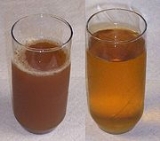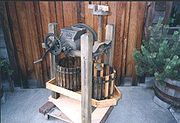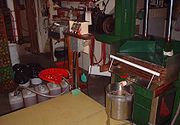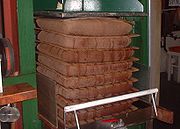
Apple cider
Encyclopedia

Apple
The apple is the pomaceous fruit of the apple tree, species Malus domestica in the rose family . It is one of the most widely cultivated tree fruits, and the most widely known of the many members of genus Malus that are used by humans. Apple grow on small, deciduous trees that blossom in the spring...
s. It may be opaque due to fine apple particles in suspension and may be tangier than conventional filtered apple juice
Apple juice
Apple juice is a fruit juice manufactured by the maceration and pressing of apples. The resulting expelled juice may be further treated by enzymatic and centrifugal clarification to remove the starch and pectin, which holds fine particulate in suspension, and then pasteurized for packaging in...
, depending on the apples used.
This untreated cider is a seasonally produced drink of limited shelf-life that is typically available only in fall
Autumn
Autumn is one of the four temperate seasons. Autumn marks the transition from summer into winter usually in September or March when the arrival of night becomes noticeably earlier....
, although it is sometimes frozen for use throughout the year. It is traditionally served on the Halloween
Halloween
Hallowe'en , also known as Halloween or All Hallows' Eve, is a yearly holiday observed around the world on October 31, the night before All Saints' Day...
, Thanksgiving
Thanksgiving
Thanksgiving Day is a holiday celebrated primarily in the United States and Canada. Thanksgiving is celebrated each year on the second Monday of October in Canada and on the fourth Thursday of November in the United States. In Canada, Thanksgiving falls on the same day as Columbus Day in the...
, and Christmas
Christmas
Christmas or Christmas Day is an annual holiday generally celebrated on December 25 by billions of people around the world. It is a Christian feast that commemorates the birth of Jesus Christ, liturgically closing the Advent season and initiating the season of Christmastide, which lasts twelve days...
holidays, sometimes heated and mulled
Mulled wine
Mulled wine, variations of which are popular in Europe, is wine, usually red, combined with spices and typically served warm. It is a traditional drink during winter, especially around Christmas and Halloween.-Glühwein:...
.
Nomenclature

Cider
Cider or cyder is a fermented alcoholic beverage made from apple juice. Cider varies in alcohol content from 2% abv to 8.5% abv or more in traditional English ciders. In some regions, such as Germany and America, cider may be termed "apple wine"...
is used for the fermented alcoholic drink in most of the world, the term hard cider is used in the United States and much of Canada. In the United States, the distinction between plain apple juice and cider is not well established.
Some individual states do specify the difference. For example, according to the Massachusetts Department of Agricultural Resources "Apple juice and apple cider are both fruit beverages made from apples, but there is a difference between the two. Fresh cider is raw apple juice that has not undergone a filtration process to remove coarse particles of pulp or sediment. Apple juice is juice that has been filtered to remove solids and pasteurized so that it will stay fresh longer. Vacuum sealing and additional filtering extend the shelf life of the juice." In Canada, the Canadian Food Inspection Agency also regulates "unpasteurized apple cider".
Commercial production

Hydraulic press
A hydraulic is a machine using a hydraulic cylinder to generate a compressive force. It uses the hydraulic equivalenta mechanical lever, and was also known as a Bramah press after the inventor, Joseph Bramah, of England. He invented and was issued a patent on this press in 1795...
then squeezes the layers together, and the juice flows into refrigerated tanks. The juice is bottled and sold as apple cider.
Early forms of production involved a man or horse powered crusher consisting of a stone or wood trough with a heavy circulating wheel to crush the fruit, and a large manual screw press
Screw press
A screw press is a type of machine press in which the ram is driven up and down by a screw. The screw shaft can be driven by a handle, or a wheel. It works by using a coarse screw to convert the rotation of the handle or drive-wheel into a small downward movement of greater force. The overhead...
to generate the pressure needed to express the juice from the pulp. Straw was commonly used to contain the pulp during pressing, although later, coarse cloth came into use. As technology advanced, rotary drum "breakers" came into use, and small scale manual basket style presses, such as the farm press pictured. Today nearly all small pressing operations use electric-hydraulic equipment with press cloths and racks both of polypropylene
Polypropylene
Polypropylene , also known as polypropene, is a thermoplastic polymer used in a wide variety of applications including packaging, textiles , stationery, plastic parts and reusable containers of various types, laboratory equipment, loudspeakers, automotive components, and polymer banknotes...
in what is commonly called a "rack and cloth press", and electric hammermill shredders. These modern systems are capable of producing 1 litre (0.264172037284185 US gal) of juice from as little as 5 kilograms (11 lb) of fresh apples.
Pasteurization
Due to E. coli O157:H7 outbreaks from unpasteurized apple cider and other outbreaks from contaminated fruit juices, the U.S. Food and Drug Administration (FDA) proposed new regulations in 1998, and Canada followed suit in 2000.The bulk of cider production and sale fell under the umbrella of proposed 1998 U.S. Food and Drug Administration regulations applying to all fresh fruit and vegetable juices.
In 2001, the regulations were finalized, with the FDA issuing a rule requiring that virtually all juice producers follow Hazard Analysis and Critical Control Points
Hazard Analysis and Critical Control Points
Hazard analysis and critical control points, or HACCP , is a systematic preventive approach to food safety and pharmaceutical safety that addresses physical, chemical, and biological hazards as a means of prevention rather than finished product inspection...
(HACCP) controls, using either heat pasteurization, ultraviolet germicidal irradiation
Ultraviolet germicidal irradiation
Ultraviolet germicidal irradiation is a sterilization method that uses ultraviolet light at sufficiently short wavelength to kill microorganisms. It is used in a variety of applications, such as food, air and water purification. UV has been a known mutagen at the cellular level for more than...
(UVGI), or other proven methods. As a result, all apple cider sold in the United States, other than sales directly to consumers by producers (such as juice bars and roadside farmstands), must be produced using HACCP principles to achieve a "5 log" reduction in pathogens. While the use of UVGI treatment and other technologies meet legal requirements, heat pasteurization is the most commonly used method.
Unpasteurized cider

Heirloom plant
An heirloom plant, heirloom variety, or heirloom vegetable is a cultivar that was commonly grown during earlier periods in human history, but which is not used in modern large-scale agriculture...
, varieties are used.
Today, unpasteurized cider is generally sold only on-site at orchard
Orchard
An orchard is an intentional planting of trees or shrubs that is maintained for food production. Orchards comprise fruit or nut-producing trees which are grown for commercial production. Orchards are also sometimes a feature of large gardens, where they serve an aesthetic as well as a productive...
s or small rural mills in apple growing areas. In the absence of pasteurization, naturally occurring yeasts in the cider are not killed and they can cause fermentation with time. Even with refrigeration, cider will begin to become slightly carbonated within a week or so and eventually become so-called hard cider as the fermentation process turns sugar into alcohol. Some producers use this fermentation to produce hard cider, and some carry it to the further acetification process to produce apple cider vinegar
Apple cider vinegar
Apple cider vinegar, otherwise known as cider vinegar or ACV, is a type of vinegar made from cider or apple must and has a pale to medium amber color...
.
Variations
"Hot apple cider" or "mulled cider" (similar to "WassailWassail
The word Wassail refers to several related traditions; first and foremost wassailing is an ancient southern English tradition that is performed with the intention of ensuring a good crop of cider apples for the next year's harvest...
") is a popular fall (autumn) and winter beverage, consisting of apple cider, heated to a temperature just below boiling, with cinnamon
Cinnamon
Cinnamon is a spice obtained from the inner bark of several trees from the genus Cinnamomum that is used in both sweet and savoury foods...
, orange peel
Zest (ingredient)
Zest is a food ingredient that is prepared by scraping or cutting from the outer, colorful skin of citrus fruits such as lemon, orange, citron, and lime. Zest is used to add flavor to foods....
, nutmeg
Nutmeg
The nutmeg tree is any of several species of trees in genus Myristica. The most important commercial species is Myristica fragrans, an evergreen tree indigenous to the Banda Islands in the Moluccas of Indonesia...
, clove
Clove
Cloves are the aromatic dried flower buds of a tree in the family Myrtaceae. Cloves are native to the Maluku islands in Indonesia and used as a spice in cuisines all over the world...
s, or other spice
Spice
A spice is a dried seed, fruit, root, bark, or vegetative substance used in nutritionally insignificant quantities as a food additive for flavor, color, or as a preservative that kills harmful bacteria or prevents their growth. It may be used to flavour a dish or to hide other flavours...
s added.
"Sparkling cider" is a carbonated
Carbonation
Carbonation is the process of dissolving carbon dioxide in water. The process usually involves carbon dioxide under high pressure. When the pressure is reduced, the carbon dioxide is released from the solution as small bubbles, which cause the solution to "fizz." This effect is seen in carbonated...
nonalcoholic beverage made from unfiltered or filtered apple cider. It is sometimes served at celebrations as a non-alcoholic alternative to champagne.
"Cider doughnut
Cider doughnut
Cider doughnuts are a harvest tradition in autumn and are sometimes sold at cider mills. They are often paired with apple cider, and may be covered with cinnamon...
s" are sometimes sold at cider mills, containing cider in the batter. Visiting apple orchards in the fall for cider, doughnuts, and you-pick apples is a large segment in agritourism
Agritourism
Agritourism, as it is defined most broadly, involves any agriculturally-based operation or activity that brings visitors to a farm or ranch. Agritourism has different definitions in different parts of the world, and sometimes refers specifically to farm stays, as in Italy...
.

